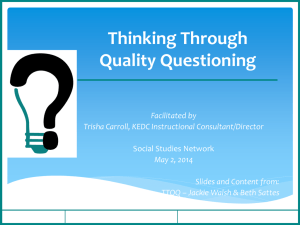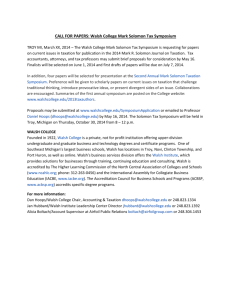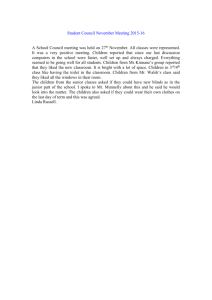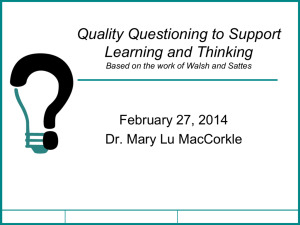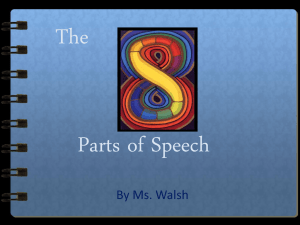July TTQQ handout ppt
advertisement
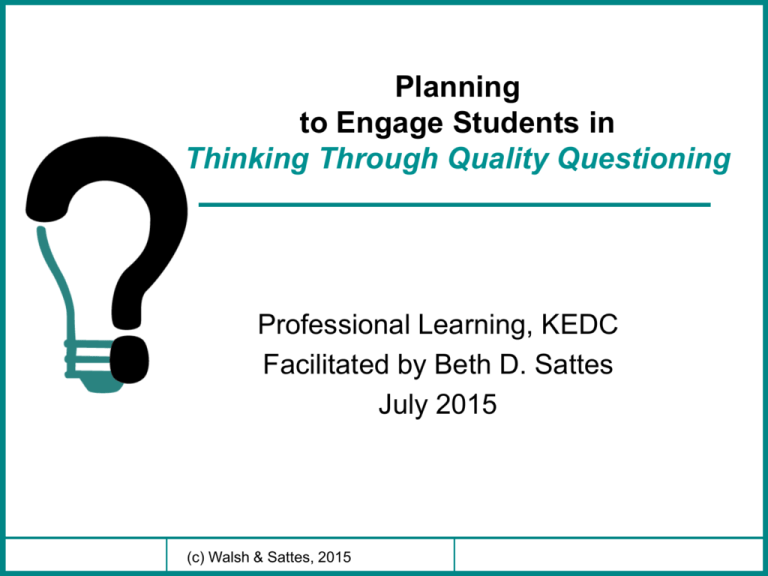
Planning to Engage Students in Thinking Through Quality Questioning Professional Learning, KEDC Facilitated by Beth D. Sattes July 2015 (c) Walsh & Sattes, 2015 Essential Question How can we plan for quality questioning in order to promote higher levels of engagement, thinking, and learning? (c) Walsh & Sattes, 2015 2 Focus Areas for Planning • Questions that prompt students to think. • Anticipation of student responses and generation of possible follow-up moves. • Response structures to support thinking and participation by all. • Norms and structures that support a culture for student thinking and learning. (c) Walsh & Sattes, 2015 3 Questioning Is a Process • Questions • Participants (Questioner & Respondents) • Responses (Answers) • Reactions (Feedback & Scaffolding) • Culture (Expectations/Norms & Relationships) (c) Walsh & Sattes, 2015 4 All-too-frequent Pattern of Classroom Questioning • “Low-level” Questions • Many students do not feel response-able for thinking and answering • Students volunteer (or call out) answers • Teacher evaluates student response, answers question, or moves on to another student • Most students are unengaged in process (c) Walsh & Sattes, 2015 5 Quality Questioning is a Process, Not a Program • Integral part of teaching that results in high levels of rigor and learner engagement • Integral part of instructional planning • Requires “re-culturing” to involve students as partners in their own learning • Requires intentionality (c) Walsh & Sattes, 2015 6 5 Organizing for Work in Collaborative Groups What? Roles and norms for collaborative group work Why? To promote effective group functioning and support learning of all members How? Review roles & responsibilities for group members, p. 5, Activity Packet; assign roles for first activity. Individually, review the group norms. Select the one on which you would like to focus today and tomorrow—to maximize group effectiveness. (c) Walsh & Sattes, 2015 7 What Do I Know and Want to Know About Our Learning Targets? 6 What? Think-Puzzle-Explore (KWL 2.0) Why? To make meaning of identified learning targets, connect to prior knowledge, and stimulate curiosity How? Select the learning target that most interests you, and identify (1) what you think you know about it; (2) questions you have related to it; and (3) how you might explore your questions with colleagues (page 6, Activity Packet). (c) Walsh & Sattes, 2015 8 33 Debrief Think-Puzzle-Explore • In what ways did Think-Puzzle-Explore engage you in thinking? • This routine has been compared to K-W-L. How does the wording stimulate more learner thinking than K-W-L? • For what purposes might you use this thinking routine (i.e., response structure) with your students? Would you modify it for your students? If so, how? (c) Walsh & Sattes, 2015 9 Personal Commitments 1. Commit to reflecting on my personal questioning practice. 2. Commit to working with colleagues to plan questions and response structures 3. Feel comfortable using the book, Thinking Through Quality Questioning, as a resource in my planning and teaching. (c) Walsh & Sattes, 2015 10 Plan Questions That Prompt Students to Think and Provide Formative Feedback to Teacher and Students (c) Walsh & Sattes, 2015 11 Reasons for Questioning “I suggest that there are only two good reasons to ask questions in class: to cause thinking and to provide information to the teacher about what to do next.” —Dylan Wiliam, Embedded Formative Assessment, p. 79 (c) Walsh & Sattes, 2015 12 Quality Questions: Planned to Stimulate Thinking and Engagement Quality Questions are powerful tools for engaging students in thinking. To increase the likelihood that students will think in response to a QQ, teachers need to plan focus questions or pivotal questions that are aligned with standards and student learning targets and that stimulate student thinking. (c) Walsh & Sattes, 2015 13 1st Consideration in Planning Questions: Do you plan to engage students through recitation or discussion? • Recitation is teacher-directed and teacher-centered • Discussion is more student-directed and student-centered (c) Walsh & Sattes, 2015 14 Recitation • The most common context for classroom questioning. • Teacher asks a question, calls on one student to respond, gives an evaluation of the rightness or wrongness of the answer, and asks another question. • Sometimes called I-R-E…Initiation, Response, Evaluation, or I-R-F. . . Initiation, Response, Feedback (c) Walsh & Sattes, 2015 15 Pattern of Talk in Recitation S T S S (c) Walsh & Sattes, 2015 16 Discussion • Teacher typically poses one open-ended question. Students are challenged to think deeply, listen respectfully to one another, and develop new understandings. • The teacher question provides focus. Student thinking and interactions determine the depth and dimensions of the response. • According to research, discussion appears in classrooms less than 3 percent of the time. (c) Walsh & Sattes, 2015 17 Pattern of Talk in Discussion S T S S (c) Walsh & Sattes, 2015 18 (c) Walsh & Sattes, 2015 19 Comparing the Purposes: Questioning in Discussion and Questioning in Recitation 7 What? Reading and Paired Dialogue Why? To think deeply about the distinguishing purposes of questioning in discussion and of the questions that prompt true discussion How? Stand and connect with a partner from a different table. Individually read and reflect on two charts that compare discussion to recitation. Talk together in response to prompts following each chart. (c) Walsh & Sattes, 2015 20 7 Purposes of Questioning in: Recitation Discussion • To develop foundational knowledge and skills • To provide drill and practice opportunities • To assess what students know and build individual accountability* • To encourage student selfassessment* • To cue students on what’s important to know • To encourage student (not teacher) talk* • To make personal meaning and connect to prior understandings • To extend or deepen thinking • To listen to understand and appreciate diverse points of view • To learn how to disagree in a civil manner • To reflect on one’s own and others’ beliefs • To develop a life skill important for working in groups *Also appropriate purposes in discussion (c) Walsh & Sattes, 2015 21 7 Characteristics of Questions in: Recitation • What is in question is whether or not the students know the teacher’s (or “the correct”) answer. • Teacher knows the answers before asking. • Questions are usually at the Remember and Understand levels. • Questions are aligned with standards and learning targets.* • Teacher usually poses many questions. *Also appropriate for questions in Discussion • Questions are “true” or authentic questions. • Questions are open for discussion, not closed for answer. • Questions are at higher cognitive levels. • Questions engage students personally and emotionally. • Teacher poses one question for discussion; other questions emerge from both students and teacher. discussion (c) Walsh & Sattes, 2015 22 Review of Component 3b, Questioning and Discussion Technique 8-11 What? Here’s What, So What? Now What? Why? Review and analyze description of questioning and discussion technique (3b) from the Kentucky Framework for Teaching How? Following directions on page 8 of the Activity Packet, individually and silently read pp. 9-11 to identify the practices/skills that you and your students most need to develop. (c) Walsh & Sattes, 2015 23 KY Framework for Teaching—3B Questioning & Discussion Techniques 11 Accomplished Exemplary Although the teacher may use some low-level questions, [most are] designed to promote thinking and understanding Teacher uses a variety of questions to challenge students cognitively, advance high-level thinking and discourse, and promote metacognition. Teacher creates a genuine discussion among students, providing adequate time for students to respond and stepping aside when appropriate. Teacher engages most students in discussion, employing a range of strategies to ensure that most students are heard. (c) Walsh & Sattes, 2015 Students formulate many questions, initiate topics, and make unsolicited contributions. Students themselves ensure that all voices are heard in the discussion. 24 12-13 What are the characteristics of a quality question? Compare, Contrast, Speculate, Share • Stand and find a partner in your grade level and/or discipline. Select 2 of the six pairs of questions on pages 12-13 of the Activity Packet to analyze and discuss. • Speculate about why the revised questions in your selected pairs are improvements on the original questions, identifying as many potential reasons as you can. Jot these down. (c) Walsh Sattes, 2015 • Be ready to &share with others. 25 Five Dimensions of Quality Questions • Content Focus • Instructional Purpose • Cognitive Level • Appropriateness to Context • Wording/Syntax See Fig. 2.2, pp. 19-20, TTQQ (c) Walsh & Sattes, 2015 26 14-15 1. Content Focus • Aligned with desired learning outcomes? (Rigor) – Promotes identified KCAS – Relates to identified student learning target(s) • Addresses student needs, interests, and experiences? (Relevance) – Within students’ zone of proximal development – Related to real-world experiences, when appropriate • Connected to prior learning in subject under study, to other subjects, or to out-of-school learning? (Relationships) (c) Walsh & Sattes, 2015 27 Consider the Type of Knowledge Embedded in Standard (Rigor) Knowledge Dimension of Revised Bloom • Factual Knowledge • Conceptual Knowledge • Procedural Knowledge • Metacognitive Knowledge (p. 22, TTQQ) (c) Walsh & Sattes, 2015 28 Taxonomy Table, Revised Bloom Knowledge Dimension Cognitive Process Dimension Remember Understand Apply Analyze Evaluate Create Facts Concepts Procedures Metacognition (c) Walsh & Sattes, 2015 29 Consider the Interconnectedness of Knowledge Across Students’ Experiences (Relevance & Relationships) Christenberry’s Questioning Circles, p. 24, TTQQ Content under study Personal interests, experiences; real-life applications (c) Walsh & Sattes, 2015 Content from other subject areas 30 2. Instructional Purpose • Consider current stage in the learning cycle. • Think about the type of question that will promote the identified instructional purpose. • Decide whether recitation or discussion best matches the purpose. (c) Walsh & Sattes, 2015 31 Stage in Learning Cycle • Introductory/Beginning—The purpose is to afford students the opportunity to connect with identified content and skills and to assess readiness and background knowledge. • Developing—The purpose is to check for understanding at identified points in the learning progression and to scaffold students’ mastery of identified knowledge and skills. • Extending—The purpose is to deepen student understanding of content and to afford opportunities for them to integrate new knowledge into their mental frameworks. (c) Walsh & Sattes, 2015 32 Types of Questions with Associated Instructional Function √ Essential Question (integrating unit or lesson of study) √ Hook Question (motivating/engaging) √ Diagnostic Question (activating prior knowledge/ conceptions) √ Check for Understanding (formative assessment) √ Probing/scaffolding (getting behind student thinking; assisting in concept development) (c) Walsh & Sattes, 2015 √ Inference Question (drawing conclusions) √ Interpretation Question (inviting analysis) √ Transfer Question (using in novel settings) √ Predictive Question (strengthening cause & effect thinking) √ Reflective Question (supporting metacognitive thinking) 33 16 What’s the Purpose? What? Review Functions of Questions, Reflect on Practice, and Share with Colleagues Why? To think about the purposes for which I and my colleagues ask questions and to consider how we might use a resource to support our thinking about instructional purpose How? Individual assessment; sharing with colleagues (p. 16, Activity Packet) (c) Walsh & Sattes, 2015 34 Component 3d. Using Assessment in Instruction 17 • Which of these question types might be used to assess student understanding? • Say Something: Find a partner. Read paragraph 3, page 17. Say something to your partner about how you use questioning to assess student performance. Listen to your partner share. (c) Walsh & Sattes, 2015 35 3. Cognitive Level “Learning is a consequence of thinking.” David Perkins, Smart Schools ........................ Remembering is a consequence of processing information—making personal meaning, making connections to what one already knows, transferring learning to a new setting, and so forth. (c) Walsh & Sattes, 2015 36 Taxonomy Table, Revised Bloom Knowledge Dimension Cognitive Process Dimension Remember Understand Apply Analyze Evaluate Create Facts Concepts Procedures Metacognition (c) Walsh & Sattes, 2015 37 Cognitive Process Dimension 1. Remember 2. Understand 3. Apply 4. Analyze 5. Evaluate 6. Create See pp. 35-37, Chapter 2, TTQQ (c) Walsh & Sattes, 2015 38 Cognitive Dimensions of Revised Bloom Taxonomy 18-19 What? Jigsaw Cooperative Learning Why? Deepen understanding of six levels of the Revised Bloom Taxonomy by learning about and teaching one; strengthen shared understanding of the kind of thinking required at each cognitive level How? Use Jigsaw Cooperative Learning as outlined on activity sheet, pages 18-19 of the Activity Packet. (c) Walsh & Sattes, 2015 39 Assignments for Jigsaw #1 #2 #3 #4 #5 #6 = = = = = = Remember Understand Apply Analyze Evaluate Create (c) Walsh & Sattes, 2015 40 Identifying Cognitive Levels of Expected Responses to Questions What? Why? How? Numbered Heads Together To review the cognitive levels of the Revised Bloom’s Taxonomy by naming the level of thinking required to answer a question. When a question is presented, talk together in your groups about what level of thinking is required to correctly answer the question. (c) Walsh & Sattes, 2015 41 Numbered Heads Together At what level of cognition would a student need to think to answer this question? When did Kentucky become a state? (c) Walsh & Sattes, 2015 42 Numbered Heads Together At what level of cognition would a student need to think to answer this question? The Smith family has three children. Their average age is 7. What might be the ages of the children? Be ready to defend your answer. (c) Walsh & Sattes, 2015 43 Numbered Heads Together At what level of cognition would a student need to think to answer this question? What is one way that the two characters in the book are different? Find a passage in the text to validate your answer. (c) Walsh & Sattes, 2015 44 Debrief Numbered Heads Together • In what ways did Numbered Heads Together engage you in thinking? • To what extent did this response structure support your learning? • For what purposes might you use this thinking routine (i.e., response structure) with your students? (c) Walsh & Sattes, 2015 45 16 4. Social Context • Whole Group • Pairs • Collaborative Groups • Individuals • Project-Based Learning (c) Walsh & Sattes, 2015 46 Component 3C: Engaging Students in Learning 20 Read the first paragraph in component C. Speculate how the process of questioning contributes to student engagement. Write down three ideas on an index card. Await directions for “Give One/Get One” to share with others. (c) Walsh & Sattes, 2015 47 How will I involve all students in forming a response to all questions? • Teacher-led, whole class – Random – Intentional matching of student with question – Whole-class response, e.g. signals, work samples, choral responses • Pairs – Think-(Write)-Pair-Share – Say Something – Turn and Talk (c) Walsh & Sattes, 2015 48 How will I involve all students in forming a response to all questions? • Collaborative Groups – Cooperative Learning, e.g., Jigsaw – Text-based protocols (e.g., National School Reform Faculty) – Synectics • Individual Reflection and Response – Free-Writes – Exit Slips (c) Walsh & Sattes, 2015 49 Changing the Context • ORIGINAL: According to Newton’s theory, what is the relationship between force, matter and energy? (question to be posed to whole class with one student selected to respond) • REVISED: Individually and silently reflect on the following question—recording your thoughts in words or graphically: According to Newton’s theory, what is the relationship between force, matter, and energy? Now turn and share your ideas with your partner and listen to your partner’s ideas. (c) Walsh & Sattes, 2015 50 Changing the Context • ORIGINAL: Decide whether you agree or disagree with the following, and be ready to provide your reasoning: The U.S. decision to delay entry into Word War II was in our best national interest. (question posed to whole class with one student selected to respond) • REVISED: Using a scale of 1-5 (where “1” = Strongly Disagree and “5” = Strongly Agree) decide the extent to which you agree and be ready to justify your rating. The U.S. decision to delay entry into Word War II was in our best national interest. Take your stand on the continuum from 1 to 5. When directed, huddle with 2-3 peers near you to share your thinking. . (c) Walsh & Sattes, 2015 51 Connection to Component 3b— Say Something “Student participation. In some classes a few students tend to dominate the discussion; other students, recognizing this pattern, hold back their contributions. The skilled teacher uses a range of techniques to encourage all students to contribute to the discussion and enlists the assistance of students to ensure this outcome.” (c) Walsh & Sattes, 2015 52 Three Forms of Discussion Teacher-Guided Structured Small Group Student-Driven (c) Walsh & Sattes, 2015 53 Teacher-Guided • Active teacher modeling of effective discussion moves • Strategic scaffolding of student thinking and speaking • Facilitation of group interaction • Teacher exhibiting of dispositions and habits of mind (c) Walsh & Sattes, 2015 54 Structured Small Group Use of protocols and thinking routines to: Scaffold social skills Provide for equitable participation Support cognitive skills Promote text-based dialogue (c) Walsh & Sattes, 2015 55 Student-Driven • Students “own” the norms of discussion, encouraging and supporting one another’s participation. • The teacher listens, observes, and take notes—intervening only when students “get stuck” or fail to adhere to norms/guidelines (c) Walsh & Sattes, 2015 56 5. Grammar and Word Choice Are your questions clear, succinct, and understandable when delivered orally? How can breaking a potential question into smaller “chunks” improve its understandability? How can we reword questions to improve their understandability and increase their cognitive demands? (c) Walsh & Sattes, 2015 57 Grammar/Understandability What were the causes leading to the American Revolution, and how could it have been prevented? “Taxation without representation” was one of the colonists’ rallying cries against England. In what different ways might England have addressed this concern to reduce the chances of a revolution? (c) Walsh & Sattes, 2015 58 Tips for Polishing A Question 1. Move from remember to understand (or higher) level of the Revised Bloom Taxonomy. 2. Start with a statement that focuses student attention and helps them activate prior knowledge. 3. Provide the “answer” to a remember level question in a statement. Then pose a question that asks a student to explain or justify this fact. 4. Connect to real life, other topics, and/or other content areas. 5. When possible, pose as a puzzle or challenge. 6. Read question aloud to see if it is clear and understandable. (c) Walsh & Sattes, 2015 59 22-23 Resource for Editing to Improve or Refine a Question • Find a partner from your discipline and grade level. Silently and individually review pages 2223. • Select a question that one of you has brought. Think together about ways to edit the question, using the five components as a guide for your thinking. • Write an “improved” quality question. Be ready to share and to stipulate in which ways it is improved. (c) Walsh & Sattes, 2015 60 Looking Back and Looking Forward: Ink Think 24 What? Ink Think Why? To reflect on yesterday’s learning, and to surface prior knowledge on topics to be addressed today. How? Individually reflect on four questions (p. 24, Act. Packet); as a group, collaboratively and silently create a concept map. (c) Walsh & Sattes, 2014 61 Ink Think Matching standards • Move to the posted question that matches the color of your marker. relevant somethin This n that Appropriate use smothering • In silence, record your answers as a concept map (c) Walsh & Sattes, 2014 62 Move in a Clockwise Direction • Continue using your group’s marker color. Read through the ideas generated by the previous group. • Put a checkmark or star beside those with which you agree. • Continue to add to the visual; provide examples; continue to expand. (c) Walsh & Sattes, 2014 Matching standards relevant somethin This n that Another Appropriate use New idea smothering something 63 Return to Your Original Question to Sort Ideas • Now you may talk. Name a – facilitator (to keep the group on task and ensure that all speak) and a – recorder/reporter • Look for patterns. Cluster the ideas on your mindmap into large concepts/categories. • Give each category a name (1-4 words) (c) Walsh & Sattes, 2014 64 Debrief Ink Think • In what ways did Ink Think engage you in thinking? • How might you use this thinking routine with your students? How would you modify it? (c) Walsh & Sattes, 2014 65 Anticipate Student Responses and Generate Possible Follow-up Moves to Develop Thinking Skills (c) Walsh & Sattes, 2015 66 25 Expect Thoughtful Responses What? Four-Square Share Why? To explore a reading and deepen comprehension by identifying key ideas, listening to others’ perspectives, & summarizing How? Read the excerpt from pp. 49-50, from Thinking through QQ, on the separate handout. Follow directions on page 25 of the Activity Packet, using the template to record your own and others’ ideas. (c) Walsh & Sattes, 2015 67 Debrief Four-Square Share • In what ways did this thinking routine engage you in thinking? • What was the value and why? • For what purposes might you use this thinking routine with your students? Would you modify it for your students? If so, how? (c) Walsh & Sattes, 2015 68 Partner with Students: Provide Clear Expectations • TTQQ suggests three sets of norms or expectations to introduce to students. • One set has to do with the PURPOSE of questions. • Read through the expectations, page 26 of the Activity Packet. • With a partner, complete the So What? And Now What? columns of the chart. (c) Walsh & Sattes, 2015 69 Student Response-ability TTQQ Expectations: What Many Students Believe: Think about each question, and decide what you think you know. I should try to guess the teacher’s answer. Be ready to share your thinking when called upon. If you don’t respond when called upon, you will be accountable for answering later. I don’t have to think of a response because someone else will answer. Think more deeply—and expand upon your response— when asked a follow-up question. If the teacher asks a follow-up question, my answer is probably wrong. (c) Walsh & Sattes, 2015 70 28-29 Plan for Student Responses What? Why? Sentence-Phrase-Word How? Read an excerpt (p. 28, Activity Packet) from Questioning for Discussion, and follow the protocol for Sentence-Phrase-Word presented on page 29 of Activity Packet. Identify key ideas in a short reading, and engage in dialogue with colleagues about this topic. (c) Walsh & Sattes, 2015 71 30 Anticipate Student Responses and Generate Follow-Up Questions • Expected Complete Response • Partially Correct Response • Incorrect Response • No Response (c) Walsh & Sattes, 2015 72 31 Generate Possible Student Responses and Follow-Up Moves • Refer back to the question you revised (or created) in yesterday’s activity. • Using the blank template in the Activity Packet, p. 31, collaboratively generate expected and probable student responses and possible follow-up moves. (c) Walsh & Sattes, 2015 73 Scaffolding Teacher scaffolding assists students in correcting or extending their knowledge and thinking. Which of the following is NOT appropriate when scaffolding? 1. Providing students with the correct answer 2. Asking students to repeat the question 3. Asking questions to get behind student thinking Walsh & Sattes, 2014 74 Scaffolding What does a teacher need to find out and/or keep in mind when scaffolding? 1. The expected (i.e., correct or acceptable) answer 2. The thinking behind the answer given by a student 3. The knowledge and skills required to give an acceptable answer 4. All of the above Walsh & Sattes, 2014 75 Scaffold Student Thinking and Learning Say Something “Scaffolding is the help given to a learner that is tailored to that learner’s needs in achieving his or her goals of the moment. The best scaffolding provides this help in a way that contributes to learning.” —Sawyer (2009, p. 11) Walsh & Sattes, 2014 76 Two Pieces of Data Required for Effective Scaffolding • Learning Goals (or Learning Targets) • Student’s Current Level of Understanding (determined by questioning) Walsh & Sattes, 2014 77 Zone of Proximal Development (ZPD) Actual Development Level ZPD Level of Potential Development Walsh & Sattes, 2014 78 Say Something “For example, telling someone how to do something or doing it for them may help them accomplish their immediate goal; but it is not scaffolding because the child does not actively participate in the construction of knowledge. In contrast, effective scaffolding provides prompts and hints that help learners figure it out on their own.”—Sawyer (2009, p. 11) Walsh & Sattes, 2014 79 Sample Stems to Sustain Student Thinking • Stems to Extend Student Thinking o Can you say more about ___? o I’d like to get behind your thinking • Stems to Clarify or Narrow o Can you give me an example? • Stems to Build Accountability for Evidence o What makes you say that? o What’s the evidence? Walsh & Sattes, 2014 80 Afford students time to think—and teach them how to use this time. (c) Walsh & Sattes, 2015 81 Think Time for Students—and Teachers! (c) Walsh & Sattes, 2015 82 Pause 3-5 seconds after posing a question to provide time for students to think about the question and to form their response. Think Time 1 (c) Walsh & Sattes, 2015 The length of time a teacher pauses after asking a question before naming a student to respond 83 Model of How Thinking Works Input from Outside Environment Adapted from Daniel Willingham, Why Don’t Students Like School? 2009, p. 11 (c) Walsh & Sattes, 2015 Working Memory— Where Thinking Occurs Long-term Memory (repository of knowledge) 84 Responding As a Process Attend to the Question Bring Question to Working Memory & Decode Search Long-term Memory for Relevant Knowledge (c) Walsh & Sattes, 2015 Bring Relevant Knowledge to Working Memory & Form a Response Answer Question Out Loud 85 Pause 3-5 seconds after the speaker responds to allow time for continued thinking and speaking. Think Time 2 (c) Walsh & Sattes, 2015 The length of time a teacher pauses after a student stops talking in response to a question before giving feedback or calling on another student 86 Suggested Think Time Pattern Teacher Question Think Time 1 Student Response Talk by students (c) Walsh & Sattes, 2015 Think Time 2 P A U S E comes Teacher Reaction P A U S E in bursts 87 Activity: What Benefits Are Associated With Think Times?— Choose and Speculate • Turn to page 54 in TTQQ, and review the bulleted list of benefits of think times (wait times). • Select the benefit that you would most value for your students. Speculate as to why consistent use of think times would produce this result. Record these ideas on an index card. (c) Walsh & Sattes, 2015 88 Benefits of Think Time— Card Swap • Stand and share your selected benefit and speculation with a colleague not seated at your table. Listen to your partner’s selection. • Swap cards. Share the info on your new card with a different colleague. Exchange cards again. • Continue making exchanges until time is called. (c) Walsh & Sattes, 2015 89 Debrief Card Swap • In what ways did “card swap” engage you in thinking? • How did the structures for this activity support your engagement? • For what purposes might you use this thinking routine with your students? Would you modify it for your students? If so, how? (c) Walsh & Sattes, 2015 90 Student Use of Think Times TTQQ Expectations: Everyone: Use the pause after a question to think about the question and decide on your answer. 27 What Many Students Believe: We should try to raise our hands or call out an answer as quickly as possible. OR We can zone out and let someone else answer. Responding Student: Think about your response—as you are speaking If a teacher doesn’t provide me with and during the time provided after immediate reinforcement, my answer you stop talking—and add to or must be wrong. modify your thinking. Listening Students: Compare the response you developed during the 1st think time to your classmate’s answer, and be ready to agree or disagree with a rationale. (c) Walsh & Sattes, 2015 Once someone else answers, I’m really off the hook. The teacher will evaluate other students’ answers. 91 Select Response Structures to Support Thinking and Participation By All (c) Walsh & Sattes, 2015 92 33 Activity: Who will answer? What? IQ (Insight-Question) Pairs Why? To formulate a thoughtful response to a short reading in preparation for exchanging ideas with a partner. How? Read the first two paragraphs beneath “Match to Social Context” on pages 37-38 of TTQQ; jot down an inference you made from the reading and a question that comes to mind. When both you and your partner have completed reading and thinking, exchange insights and questions. (page 33, Activity Packet) (c) Walsh & Sattes, 2015 93 Debrief IQ Pairs • In what ways did this thinking routine engage you in thinking? • What was the value and why? • For what purposes might you use this thinking routine with your students? Would you modify it for your students? If so, how? (c) Walsh & Sattes, 2015 94 Insight About Relying on Hand-raisers to Volunteer Responding to questions matters. “So when teachers allow students to choose whether to participate or not . . . they are actually making the achievement gap worse.” —Dylan Wiliam, Embedded Formative Assessment, p. 81 (c) Walsh & Sattes, 2015 95 How might response structures 36-37 scaffold development of classroom learning communities? Talk together as a team about the response structures we’ve used today. In what ways might each of these support student development of expectations associated with classroom learning communities? (pp. 36-37 of Activity Packet) (c) Walsh & Sattes, 2015 96 Create a Culture for Thinking (c) Walsh & Sattes, 2015 97 Imagining a Culture That Supports Student Engagement &Thinking— Four-Corner Visual Synectics 34 Prompt for Individual Reflection Imagine a classroom culture in which questioning is a catalyst for student engagement, thinking, and ownership of their learning. What would this classroom look, sound, and feel like? Individually record ideas, p. 34, Activity Packet (c) Walsh & Sattes, 2015 98 Visual Synectic: Which of the following is the best metaphor for your vision of student engagement? Sea Shore Flower Garden (c) Walsh & Sattes, 2015 Jungle Ocean Reef 99 Debrief Visual Synectics • In what ways did this thinking routine engage you in thinking? • What was the value, and why? • For what purposes might you use this thinking routine with your students? Would you modify it for your students? If so, how? (c) Walsh & Sattes, 2015 100 The Last Set of Norms: Equitable Participation 27 Now read through the final set of norms and expectations—related to equitable participation. With a partner, think about the “So What?” and “Now What?” Which of these three sets of norms will you introduce first to your students? Walsh & Sattes, 2014 101 35 Component 2B: Establishing a Culture for Learning • Review key ideas associated with component 2b of the Kentucky Framework for Teaching. • Consider how the norms associated with TTQQ (page 27, Activity Packet) might promote these indicators and attributes. (c) Walsh & Sattes, 2015 102 Final Reflection and Feedback • Individually and silently complete the 3-2-1 feedback form, page 41 of the Activity Packet. • Please turn in completed copy as you leave. Thank you! (c) Walsh & Sattes, 2015 103


